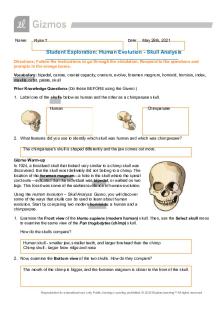Human Evolution - Lecture Notes (Spring 2019) PDF

| Title | Human Evolution - Lecture Notes (Spring 2019) |
|---|---|
| Course | Intro Evolutionary Biol |
| Institution | Georgia Institute of Technology |
| Pages | 4 |
| File Size | 160 KB |
| File Type | |
| Total Downloads | 3 |
| Total Views | 158 |
Summary
Human Evolution Lecture Notes. The professors for this course were Dr. Sam Brown and Dr. Soojin Yi....
Description
Lecture 21
4/4/19 Human Evolution
Learning Catalytics Q: Based on what you have seen so far, which trait has evolved earlier than the other? o Bipedalism Learning Catalytics Q: What would be the best clue that a fossil skull was left behind by an ape that walked more or less upright? o The foramen magnum has a position relatively far forward. Learning Catalytics Q. Which genera is likely the most recent ancestor of the genus Homo? o Australopithecus Humans are hominins o Hominins = species in lineage leading to modern humans Archaic Humans o Neanderthals & Denisovans o H. floresiensis Modern Humans o H. sapiens Human Lineage Traits o Bipedalism: most defining characteristics of hominin lineage Walking/running Associated w/: Pelvis shape Leg length & angle Position of connection b/w skull & spine (aka foramen magnum) shifted forward so we can face straight when standing Unique foot anatomy Loss of body hair may be consequence to this to create sweating o Skeletal anatomy Shorter arms to legs ratio than apes Hand anatomy (our fingers are shorter/straighter & thumbs are more opposable than apes’) o Cranial/jaw anatomy Flat face, small teeth o Big brains Progressive changes throughout hominin evolution o Language Likely shared by modern & archaic humans Common traits b/w humans & apes o Opposable thumbs o Highly social o Use tools for learning o Theory of mind o Communicate w/ humans Hominins
Lecture 21
4/4/19
o Small teeth o Flatter face o Small brain case o Small brain o Opposable big toe o Pelvis for bipedalism o Lucy fossil shows bipedalism H. erectus & H. habilis likely to been ancestors of modern humans o H. erectus: Made tools Used fire Large brains 1st migration ‘out of Africa’ Human Brain: prime example of evolutionary innovation o Large brains began to evolve earlier than hominin lineage o Apes have larger brains than other mammals o Brain evolution expedited in recent human evolution Social brain hypothesis: Our brains got bigger b/c we had to adapt to this bigger society & socializing o Especially of neocortex which is responsible for learning, memory, & cognition o Size of brain corresponds to that of species that lived in ‘mean group size’ of 148 o Dunbar’s #: 150 is mean group size for communities w/ high incentive to stay together Lot of ‘social grooming’ needed to keep group Applicable to online social networks o Language may have selective advantage as ‘cheaper’ means to offer social grooming Language evolution accompanied by physiological changes of larynx (disadvantage: easy to choke) 3 waves out of Africa o Substantial: interbreeding b/w archaic humans & anatomically modern humans o 1st wave: Homo erectus (2M years ago) some went to Europe & evolved rise to H. floresiensis o 2nd: Ancestors of Neanderthals & Denisovans (600,000 years ago) o 3rd: migration of modern humans
Lecture 21
4/4/19
more variability in African populations
Non-African populations = Decreased heterozygosity & Increased linkage disequilibrium
Learning Catalytics Q: Which piece of evidence does not support the theory of recent (200,000 years ago) African origin of humans? Mitochondrial DNA sequences coalesce to Africa popula6ons about 125,000 years ago. o Linkage disequilibrium of nuclear genes gets progressively lower as one measures popula6ons farther from Africa. (B/C IT HIGHER NOT LOWER) o Haplotype diversity of nuclear genes is greatest in Africa. o Fossils of modern humans older than 60,000 years are found only in Africa. o Non-African populations show reduced heterozygosity compared to African populations.
Contiguous introgression b/w modern & archaic humans o Neanderthal ancestry found in non-African populations o Denisovan ancestry found in Melanesians o Neanderthal-Denisovan interbreeding also observed Brain, metabolism, cooking, agriculture o Human brain uses 20% of metabolites o Humans have higher metabolic rates than other apes o Hypothesized that high metabolic rate of humans achieved by evolutionary shift of diet (from fruits to meat/tubers) o Evolution of agriculture changed history Foundation for human civilization Sedentary life Increase of population size Habitat destruction & species extinction
Lecture 21
4/4/19...
Similar Free PDFs

Human Evolution - Lecture notes 1-8
- 12 Pages

Evolution Lecture Notes
- 23 Pages

Human Cognicion Evolution
- 97 Pages

Human Evolution Gizmo - Ryan
- 8 Pages

Gizmo: Human Evolution
- 9 Pages

HISTORICAL EVOLUTION OF HUMAN RIGHTS
- 18 Pages

Human Evolution Final Study Guide
- 17 Pages

Copy of Human Evolution SE
- 7 Pages

Human- Physiology - Lecture notes 15
- 97 Pages

Law Lecture Notes - 2019
- 6 Pages
Popular Institutions
- Tinajero National High School - Annex
- Politeknik Caltex Riau
- Yokohama City University
- SGT University
- University of Al-Qadisiyah
- Divine Word College of Vigan
- Techniek College Rotterdam
- Universidade de Santiago
- Universiti Teknologi MARA Cawangan Johor Kampus Pasir Gudang
- Poltekkes Kemenkes Yogyakarta
- Baguio City National High School
- Colegio san marcos
- preparatoria uno
- Centro de Bachillerato Tecnológico Industrial y de Servicios No. 107
- Dalian Maritime University
- Quang Trung Secondary School
- Colegio Tecnológico en Informática
- Corporación Regional de Educación Superior
- Grupo CEDVA
- Dar Al Uloom University
- Centro de Estudios Preuniversitarios de la Universidad Nacional de Ingeniería
- 上智大学
- Aakash International School, Nuna Majara
- San Felipe Neri Catholic School
- Kang Chiao International School - New Taipei City
- Misamis Occidental National High School
- Institución Educativa Escuela Normal Juan Ladrilleros
- Kolehiyo ng Pantukan
- Batanes State College
- Instituto Continental
- Sekolah Menengah Kejuruan Kesehatan Kaltara (Tarakan)
- Colegio de La Inmaculada Concepcion - Cebu





